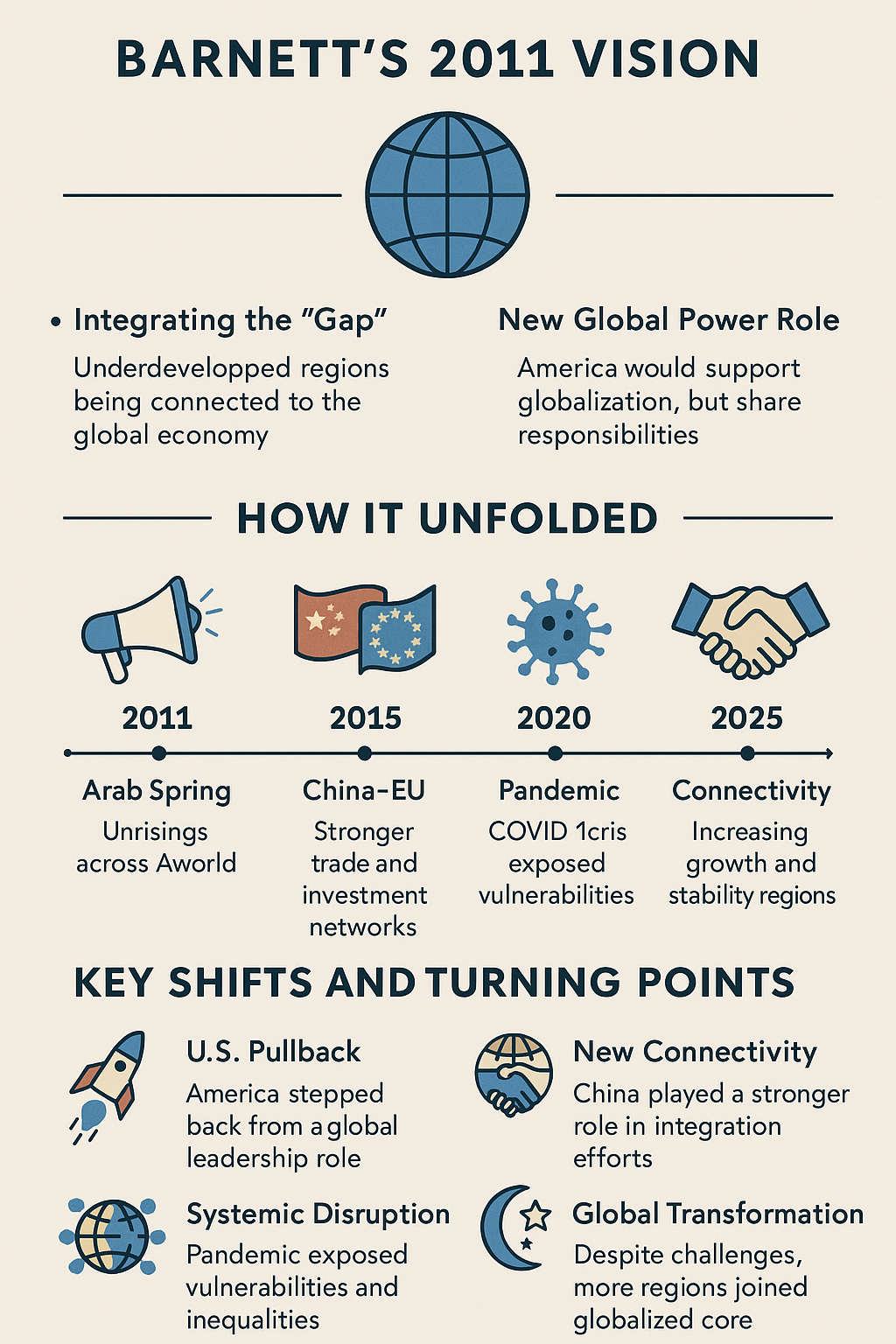In 2011, Thomas P.M. Barnett argued that the U.S. had shifted into a role of a “midwife of globalization”, no longer trying to “do globalization at the barrel of a gun,” but instead reacting to global demands for intervention. This was a major shift from the Bush-era “shock and awe” philosophy during the Iraq War, where America sought to impose political order through unilateral force. Barnett proposed that America should not fight globalization alone, but facilitate local and regional players (“natural integrators”)—like the Turks, Egyptians, Italians, and even the Chinese—to take the economic and civilizational lead after military interventions.
Barnett’s concept carried these main pillars:
- Midwifing rather than imposing: The U.S. uses its military to stabilize chaotic regions but steps back to let regional powers lead integration.
- Natural Integrators: Different regions have their own powers who are more “organic” to the local population and better suited for economic rebuilding.
- Dealing with tumult: Chaos is inevitable during economic liberalization and cultural shifts—especially with the empowerment of women and the rise of abundance over survival economies.
- Stop containing China: Barnett saw efforts to both “contain China” and “fix the world” as self-contradictory and ultimately self-destructive.
- Partnering with nations with demographics and will: Seek allies who have young populations and economic motivations, not decaying demographics and old-world inertia like much of Europe.
What has happened since 2011?
From 2011 to 2025, the world has seen an intensification of the exact trends Barnett described, but also a darker evolution:
Natural Integrators Became New Oligarchs
- Regional powers like China, Turkey, Russia, and India did expand their influence across Africa, Latin America, and Southeast Asia.
- But instead of merely integrating these regions peacefully into the global economy, many of these powers used economic expansion as tools of neocolonialism, resource exploitation, and debt entrapment (especially with China’s Belt and Road Initiative).
- Local governance often became more corrupt and subservient to new foreign elites rather than truly building independent, abundant societies.
America’s Midwifery Failed: It Was Replaced by Corporate and Military Occupations
- While America aimed to reduce footprint and facilitate integration, private military contractors, multinational corporations, and intelligence agencies filled the void instead.
- Globalist economic interests—not organic local cultures—largely dictated development.
- Examples include continued CIA interventions in Africa, Big Tech domination of infrastructure (internet, banking systems), and major U.S. and European corporations monopolizing “reconstruction” markets.
China’s Rise and De Facto Decoupling
- Despite Barnett’s advice to embrace China, American policy oscillated between engagement and antagonism.
- Starting especially after 2017–2018, U.S.-China tensions escalated into trade wars, technological decoupling, financial restrictions, and indirect proxy conflicts (e.g., Africa, South China Sea).
- The hope for “peaceful integration” into a cooperative global system now looks naive—China openly pursues a parallel world order (BRICS+, Belt and Road, digital yuan) that rivals U.S. influence.
Tumult Has Escalated, Not Subsided
- Empowerment (especially women’s rights and the internet-driven awakening of previously oppressed groups) has grown globally.
- However, it has also produced massive political instability: mass protests (Middle East, Latin America), civil wars (Sudan, Ethiopia), rising crime, and demographic shifts that fuel nationalism, religious fundamentalism, and backlash movements.
- Barnett anticipated chaos, but perhaps underestimated the sheer scale and duration of the backlash.
Consumption, Surveillance, and Control Instead of True Freedom
- Barnett hoped that economic integration would lead to freedom and abundance.
- Instead, mass digital surveillance, AI manipulation, and centralized economic control (CBDCs, ESG metrics) emerged.
- The “opportunity” for prosperity became increasingly conditional: aligned with technocratic globalist standards rather than national self-determination.
Key Lessons from Barnett’s Framework Today
| 2011 Vision | 2025 Reality |
|---|---|
| America should act as midwife, not imperialist. | America, China, and corporations engage in proxy imperialism through economics and information warfare. |
| Partner with “natural integrators” | Natural integrators became mini-imperialists themselves, serving oligarchic interests. |
| Avoid containing China while engaging the world. | Half-hearted engagement failed; now a de facto “Cold War 2.0” between U.S. and China exists. |
| Tumult is natural during transformation. | Tumult grew worse due to destabilizing neoliberal and technocratic policies. |
| Empower locals, transition from sustenance to abundance. | Transitions often exploit locals, disempowering them further under foreign influence. |
The Present and Future: Where Do We Go From Here?
Today, Barnett’s original optimism has faded. The reality is that globalization created new oligarchies, displaced old ones, and left fragile states even more vulnerable. The multipolar world is not peaceful—it’s competitive, chaotic, and often violent.
- Mass migration surges (Africa, Middle East into Europe, Latin America into the U.S.).
- Currency wars and financial decoupling are accelerating.
- New regional empires (China, Russia, India, Saudi Arabia) now vie for influence where the U.S. once stood unchallenged.
- Cultural collapse and demoralization (especially in the West) create internal vulnerabilities easily exploited by external players.
The “integration” Barnett envisioned became “consolidation” by elites rather than true empowerment of people.
Thus, the critical task for the future is not merely managing integration or globalization—it is revitalizing sovereign, moral, principle-centered civilizations who can interact respectfully, maintain independence, and prevent domination—whether from Beijing, Washington, or Davos.







